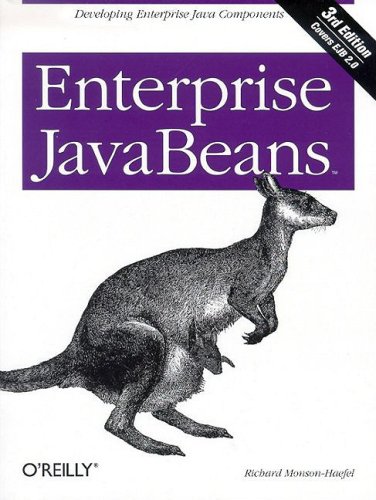
Sinossi
Offers an architectural overview of the programming language, including Entity Beans, Session Beans, transactions, design strategies, and XML deployment descriptors.
Le informazioni nella sezione "Riassunto" possono far riferimento a edizioni diverse di questo titolo.
Informazioni sull?autore
Richard Monson-Haefel is the author of Enterprise JavaBeans, 3rd Edition, Java Message Service and one of the world's leading experts and book authors on Enterprise Java. He is the lead architect of OpenEJB, an open source EJB container used in Apple Computer's WebObjects plateform, and has consulted as an architect on J2EE, CORBA, Java RMI and other distributed computing projects over the past several years.
Le informazioni nella sezione "Su questo libro" possono far riferimento a edizioni diverse di questo titolo.
Risultati della ricerca per Enterprise Javabeans
Enterprise JavaBeans (3rd Edition)
Da: Wonder Book, Frederick, MD, U.S.A.
Condizione: Very Good. Very Good condition. 3rd edition. A copy that may have a few cosmetic defects. May also contain light spine creasing or a few markings such as an owner's name, short gifter's inscription or light stamp. Codice articolo P12A-04676
Compra usato
Quantità: 1 disponibili
Enterprise JavaBeans (3rd Edition)
Da: Wonder Book, Frederick, MD, U.S.A.
Condizione: As New. Like New condition. 3rd edition. A near perfect copy that may have very minor cosmetic defects. Codice articolo I02M-02272
Compra usato
Quantità: 1 disponibili
Enterprise JavaBeans 3e (JAVA SERIES)
Da: WorldofBooks, Goring-By-Sea, WS, Regno Unito
Paperback. Condizione: Very Good. The book has been read, but is in excellent condition. Pages are intact and not marred by notes or highlighting. The spine remains undamaged. Codice articolo GOR002013557
Compra usato
Quantità: 2 disponibili
Enterprise JavaBeans (3rd Edition)
Da: Inquiring Minds, Saugerties, NY, U.S.A.
Trade Paperback. Condizione: Used - Very Good. Codice articolo 538428
Compra usato
Quantità: 1 disponibili
Enterprise JavaBeans (JAVA SERIES)
Da: AwesomeBooks, Wallingford, Regno Unito
Paperback. Condizione: Very Good. Enterprise JavaBeans (JAVA SERIES) This book is in very good condition and will be shipped within 24 hours of ordering. The cover may have some limited signs of wear but the pages are clean, intact and the spine remains undamaged. This book has clearly been well maintained and looked after thus far. Money back guarantee if you are not satisfied. See all our books here, order more than 1 book and get discounted shipping. Codice articolo 7719-9780596002268
Compra usato
Quantità: 2 disponibili
Enterprise JavaBeans (Java Series)
Da: Bahamut Media, Reading, Regno Unito
Paperback. Condizione: Very Good. This book is in very good condition and will be shipped within 24 hours of ordering. The cover may have some limited signs of wear but the pages are clean, intact and the spine remains undamaged. This book has clearly been well maintained and looked after thus far. Money back guarantee if you are not satisfied. See all our books here, order more than 1 book and get discounted shipping. Codice articolo 6545-9780596002268
Compra usato
Quantità: 1 disponibili
Enterprise JavaBeans.
Da: antiquariat RABENSCHWARZ, Braunschweig, Germania
OBroschur. Third edition, covers EJB 2.0. XIX, 567S. Guter Zustand. Size: Gr.-8°. Codice articolo 030767
Compra usato
Quantità: 1 disponibili
Enterprise JavaBeans (Java Series)
Da: Sigrun Wuertele buchgenie_de, Altenburg, Germania
Condizione: gut - gebraucht. Broschiert, 572 S., Buch in gutem altersbedingtem Zustand, Buchdeckel hinten entfernt, ohne Namenseintragung, ohne Widmung, Text sehr gut, in englischer Sprache, ISBN 0596002262, Zustand: 3, gut - gebraucht, Broschiert, O'Reilly, Beijing, , 2001 572 S., Enterprise JavaBeans (Java Series), Monson-Haefel, Richard. Codice articolo BU055682
Compra usato
Quantità: 1 disponibili
Enterprise JavaBeans (Java Series)
Da: NEPO UG, Rüsselsheim am Main, Germania
Condizione: Gut. Auflage: 3. 550 Seiten Exemplar aus einer wissenchaftlichen Bibliothek Sprache: Englisch Gewicht in Gramm: 969 22,9 x 17,4 x 2,8 cm, Taschenbuch. Codice articolo 385095
Compra usato
Quantità: 1 disponibili
Enterprise JavaBeans (3rd Edition)
Da: The Book Spot, Sioux Falls, MN, U.S.A.
Paperback. Condizione: New. Codice articolo Abebooks160791
Compra nuovo
Quantità: 1 disponibili
